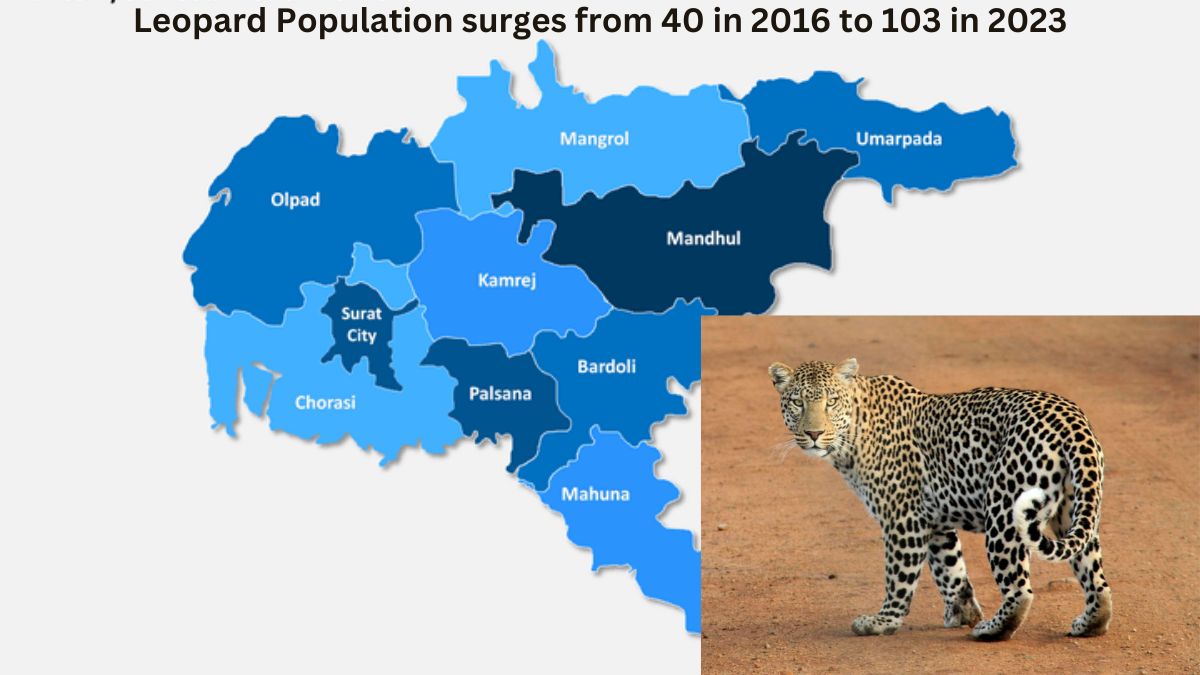Surat’s Leopard Kingdom: Unveiling the Astonishing Surge in Population
The Surat Forest Department conducted a meticulous three-day survey to ascertain the leopard population in the district

Advertisement
Surat : The number of leopards in the Surat area has increased dramatically, more than tripling in only the previous seven years. The Surat Forest Department reported that the leopard population increased from 40 in 2016 to 103 in 2023. People who are interested in wildlife and locals in the area have expressed both curiosity and alarm at the dramatic growth in leopard populations.
Rapid Growth and Conservation Efforts:
The Surat Forest Department conducted a meticulous three-day survey to ascertain the leopard population in the district. To ensure accuracy, night watch was set up at 131 designated points, with 309 dedicated forest staff deployed across the forest areas of Surat. The survey involved the placement of 20 cameras and the deployment of approximately 204 employees at various critical points.
In a bid to cover extensive areas, the Surat Forest Department strategically created a network of 70 points across the four talukas of Surat. These talukas included Mahuva, Umarpada, Mandvi, and Mangrol. Additionally, the Social Forestry Department contributed by establishing 61 points in Palsana, Bardoli, Kamrej, Allpad, and Choryasi taluks, with a total of 105 personnel deployed for the survey.
Impressive Distribution and Variation:
The survey revealed fascinating insights into the distribution of leopards across Surat district. Mandvi emerged as the taluka with the highest concentration, hosting a staggering 30 leopards. On the other hand, Palsana recorded the lowest count, with only one leopard spotted during the survey. Such variations in leopard populations within the district demonstrate the diverse habitat and ecological conditions that support these magnificent creatures.
Conservation Significance and Challenges:
The surge in the leopard population in Surat district is a testament to the effectiveness of conservation efforts and the preservation of their natural habitat. It is a positive indicator of the ecosystem’s health and the successful implementation of wildlife protection measures. However, this growth also poses challenges for both human-wildlife coexistence and long-term sustainability.
As the leopard population expands, it becomes crucial to strike a balance between conservation and mitigating potential conflicts. Surat’s rapid urbanization and increasing human activities in the region have led to habitat fragmentation, encroachment, and a higher likelihood of human-leopard encounters. Therefore, it is imperative to develop comprehensive strategies that prioritize the safety of both leopards and local communities.
“To address the challenges posed by the growing leopard population, stakeholders need to focus on promoting harmonious coexistence” said a wildlife expert. “This involves raising awareness among local communities about leopard behavior, implementing robust waste management practices to reduce attractants, and establishing protocols for handling human-leopard interactions. Additionally, wildlife corridors and protected areas should be preserved and expanded to facilitate the movement and dispersal of leopards.”
Collaborative efforts between the forest department, local authorities, and conservation organizations are paramount in ensuring the long-term survival of leopards in Surat district. By fostering understanding and empathy towards these majestic creatures, we can create an environment where humans and leopards can thrive together.
Advertisement

